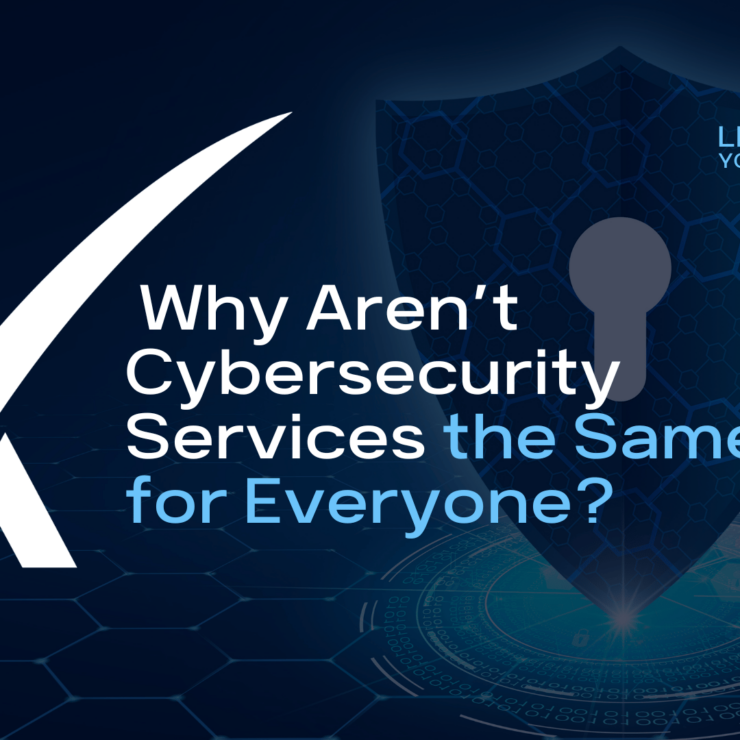Why Aren’t Cybersecurity Services the Same for Everyone?

If you’re getting outsourced cybersecurity services from a managed IT service provider, you may have been presented with options for different tiers of service. If this surprised you, it may be because you didn’t expect to have choices. You do have choices, however, because cybersecurity is about risk management, and that responsibility ultimately rests on executives’ shoulders, as do decisions about allocating resources towards managing risks.
If you are responsible for managing risks, what responsibility does your IT company carry in cybersecurity? They should provide you with a baseline security level and consult with you regarding the construction of a cybersecurity strategy that takes into account your exposure to threats, your vulnerabilities and the level of risk you’re willing to accept.
If you need to comply with regulations for data confidentiality, there are components of your cybersecurity strategy that are non-negotiable. Likewise, if you want to apply for cyber insurance or if you’re getting security standards pushed down from your customers or vendors, there are specific security tactics that you need to have in your strategy. However, even if you’re following a security framework like NIST, there are still choices to make regarding how you’ll implement security controls.
Getting the idea that cybersecurity isn’t an assembly-line process? This becomes even more clear when you consider how cyber risk is managed.
Cyber Risk Management Explained
Cyber risk is simply the inherent risk of using the internet. While every individual and organization is a target for cyber-crime, some face more risk than others because of the data that they gather and store, or because they provide access to bigger targets.
Recognizing the value of data and access to IT systems is the first step in managing cyber risk because it helps you to understand that you have something that cyber criminals want, something that they can monetize.
Then you need to get a handle on cyber threats and how you’re vulnerable. Considering the potential impact that a cyber-attack could have on your business is important in weighing the costs and benefits of your cybersecurity investments. Business impacts of a cyber-attack can include:
- Downtime of IT systems and operations
- Costs to mitigate and clean up the attack
- Legal fees and penalties
- Damaged reputation with customers, vendors, and employees
- Business failure
Determining the Appropriate Level of Cybersecurity
There’s no escaping the need for a high level of cybersecurity guidance if you’re a business leader tasked with managing cyber risk. Cyber-criminal tactics are becoming more sophisticated every day.
How do you build a cyber defense that will be effective at managing evolving threats? Start by establishing a modern security baseline.
Build a Modern Security Baseline – Includes best practices to prevent security gaps as well as tools that monitor, detect, and respond to potential threats plus establishment of data backup and recovery systems.
Insist on Vigorous Identity Management – Utilize multi-factor authentication (MFA) to add a layer of security to online accounts.
Beef Up Non-Technical Security – Document policies on how people and IT systems should access data. Train employees so they can follow policies as well as recognize and respond to potential cyber-attacks.
Invest in a Phishing Simulation Tool – Employees don’t just need cybersecurity training; they need practice on spotting suspicious email messages, text messages and phone calls.
Have a Response Plan Ready – Think through how you might respond to various cyber-attack scenarios and have a response plan ready to implement should a data breach happen.
Customizing Your Cybersecurity Strategy
Here at XPERTECHS, when we talk with clients about their cybersecurity strategy, we begin by reviewing any regulations that apply to their industry such as HIPAA, PCI, or CMMC. When compliance is involved, we help companies interpret regulations and translate them into suitable security controls.
Even if an organization doesn’t fall under regulatory compliance, they may need to utilize a specific security framework like NIST in order to prove accountability for security to a parent company, customer or vendor.
We also take into account the security measures that are required to lower risk when clients are obtaining cyber insurance. Essentially, the better the company is handling security, the more likely they are to get the best rates for cyber insurance.
Then we go into detail and the client’s business, their industry, and specific attributes that may increase their cyber risk.
Related: 3 Cyber Insurance Myths Busted
Cybersecurity Costs and Benefits
The benefit of having a robust cybersecurity strategy that’s suitable for your unique business is that you can defend your organization from cyber-attack, and if you have a breach incident, it doesn’t result in business failure. (No one can guarantee that you’ll never have a cyber-attack.)
Assessing the ROI of cybersecurity is kind of like assessing the cost of a fitness program. You know that you’re building strength, but you’ll never know how many incidents didn’t happen because of that strength.
Ultimately, it’s your job as a business leader to make decisions about the resources you dedicate to cybersecurity strategy. It’s our job as your Managed IT and Security Provider to give you the recommendations that will allow you to make well-informed decisions.
Up Your Game with XPERTECHS Managed Security
As a Managed Security Service Provider (MSSP), we work with companies to create IT and cybersecurity strategy that helps them get better business results. If that’s not what you’re getting from your current IT company, it’s time to up your game.
